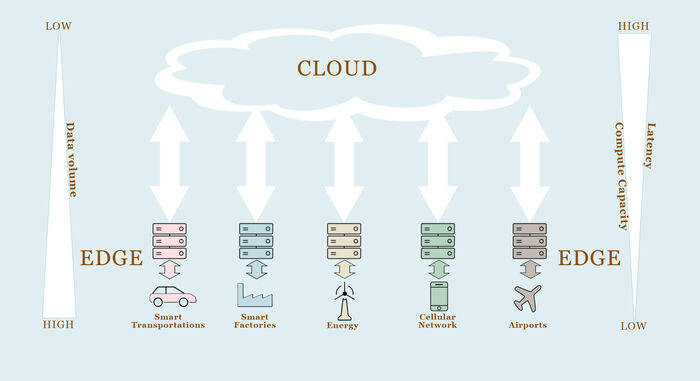Distributed Clouds - Research at the Edge

Distributed Clouds – Research at the Edge
It has been predicted that autonomous systems will constitute the fourth industrial revolution, or Industry 4.0 as it is also known. Enormous amounts of effort and money are currently being invested in self-driving delivery robots, smart houses, and autonomous cars. But none of these will become reality unless the cloud becomes faster and more efficient. Researchers at the Department of Automatic Control are about to make it happen, but how? By using automatic control, of course.
Today, clouds consist of enormous data centers, usually located where electricity is cheap and the supply reliable. The distance between these data centers and their users often results in delays in data communication. Karl-Erik Årzén is professor at the Department of Automatic Control.
“For a human, half a second or a second is not that important, but every millisecond counts for machines, robots, and cars performing calculations over the cloud. Even small delays can lead to catastrophe”, he says.
So what is the solution? Small local data centers, forming the so-called edge cloud. In the edge cloud, the boundary between the network and the data center disappears, allowing application software to be dynamically deployed in all types of nodes, i.e. base stations, near end-users, in remote large-scale data centers, or anywhere in between.
“Calculations that have to be made very quickly can be performed in edge data centers, while larger calculations, or calculations that are not urgent, can be performed in the traditional data center”, says Karl-Erik Årzén.
Other factors influencing where calculations are performed are cost, security, and the presence of reserves in the form of components or power.
Globally unique research
The types and amount of resources that should be allocated to each application, and when and where they should be deployed, are some of the resource management issues that Karl-Erik Årzén and his team are currently working on. They are also investigating dynamic decisions, such as automatic scaling of the amount of resources when the load or the available resources vary, and on-line migration of application components between nodes – all using distributed control techniques and real-time analytics.
“In this sense we are globally unique. I don’t know of anyone else using automatic control for resource management of distributed clouds”, says Karl-Erik Årzén.
However, before their research can be put into practice, a more advanced wireless system is needed. “5G is a prerequisite for edge clouds. There is no point in having edge clouds with 4G – it is simply too slow”, says Karl-Erik Årzén.
Karl-Erik Årzén and his colleagues are carrying out tests in collaboration with Ericsson, using Ericsson’s cloud platform Calvin [länk: www.ericsson.com/en/blog/2015/7/a-closer-look-at-calvin], and with the Department of Communications Engineering at LTH, where the first base station in the world using 5G technique, LuMaMi, was developed. LuMaMi is based on a technique called massive MIMO [länk: www.eit.lth.se/index.php, which simply described means that instead of each base station having only a few antennas, each station is furnished with hundreds of antennas, so it can “listen” with many more “ears”.
An autonomous revolution?
Once the new, improved distributed cloud platform and 5G are in place, autonomous systems will most likely advance to a new level of development, and their influence on society and industry will increase. Many predict an autonomous revolution within the next few years, but Karl-Erik Årzén believes that the change to a more autonomous future will be rather slow and gradual.
“I believe that more and more functions will become autonomous, but I also believe that we will still want to do a lot of things ourselves. If for no other reason to remain in control”, he says and takes driving as an example.
“I think most people like to drive, and most of us will probably want to continue to control our car even in the future.”
Regardless of whether the transition to an autonomous future is fast or slow, the possibilities are endless, and a substantial part of the cutting-edge research enabling it is taking place at Swedish research facilities, including the Department of Automatic Control. Openness to collaboration with others, and strong, sustainable industrial cooperation are prerequisites for this.
Film
Autonoma självstyrande system och fordon
[länk: https://www.youtube.com/watch?v=P0ygcWLYwaM&feature=youtu.be]
– A film about autonomous systems and vehicles produced by the Knut and Alice Wallenberg Foundation (in Swedish).
